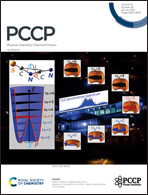The role of native point defects and donor impurities in the electrical properties of ZnSb2O4: a hybrid density-functional study†
Abstract
The ceramic material zinc antimony oxide ZnSb2O4 has promising electrical and magnetic properties, making it suitable for various applications such as electrochemical and energy storage. However, the effects of point defects and impurities on its electrical properties have never been revealed. Here, we employ hybrid density-functional calculations to investigate the energetics and electronic properties of native point defects and donor impurities in ZnSb2O4. The energetically favorable configurations of native point defects under selected growth conditions (O-rich and O-poor) are identified based on the calculated formation energies. The study finds no shallow donor and shallow acceptor defects with low formation energies. Still, the oxygen vacancy (VO) has the lowest formation energy among the donor-type defects under O-rich and O-poor conditions. However, it acts as a very deep acceptor, making it unlikely to provide free electron carriers to the conduction band. Moreover, electron carriers are likely to be compensated by the formation of zinc vacancies (VZn) and the zinc substituted for antimony (ZnSb), which behave as dominant acceptors. Our analysis of the charge neutrality conditions estimates that the Fermi level of undoped ZnSb2O4 would be pinned in a range that is 2.60 eV to 3.12 eV above the VBM for O-rich to O-poor growth conditions, respectively, suggesting that this material is semi-insulating. The possibility of enhancing free electron carriers by doping with Al, Ga, In, and F impurities is also investigated. Our results, however, indicate that high n-type conductivity is hindered by self-compensation in which the impurities additionally act as electron killers. Our results suggest that other impurity candidates and approaches may need to be considered to efficiently dope this material into n-type. Overall, this work paves the way for point defect engineering in this class of ternary oxides.



 Please wait while we load your content...
Please wait while we load your content...